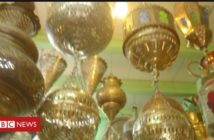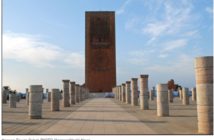Anba News Agency
Thais Sousa
tsousa@anba.com.br
The heritage of Chapada do Araribe in Cariri, Brazil, is the subject of study of Moroccan researcher Nabila Jebbouri. She advocates for the site to be recognized by UNESCO.
São Paulo – Oasis, culture and the residents themselves make the sertão of Cariri a more Moroccan place. It’s the opinion of Nabila Jebbouri, a researcher from Morocco that works in cultural heritage and human development. The 28-years-old currently works between Morocco and the region of Cariri in the state of Ceará, Brazil.
A PhD student at the University of Hassan II Casablanca, she had already studied two elements she would come to see again in Brazil. First, the oasis of her home region. Second, a Moroccan festival around the so-called Battle of Three Kings. The battle was fought in 1578 in northern Morocco and ended up in the disappearance of Don Sebastian, king of Portugal.
The researcher discovered that the story, which is part of Moroccan culture, arrived in Brazil and, in the Northeast, influenced the Sebastianism – which believed in the return of Don Sebastian as a hope to improve people’s lives. “I didn’t know that people in Brazil talked about the Battle of the Three Kings. When I gave a lecture in Portugal, I met Alemberg Quindins, president of Casa Grande Foundation in Ceará, who told me there was a festival about the battle here, so I came to see it,” she said.
In 2019, the Moroccan came to Brazil for the first time and attended the traditional fest in São José do Belmonte in Pernambuco. From then on, Jebbouri decided to study deeper relations between Cariri and what she already knew and studied in Morocco, including the culture and the oasis she would come to know in the middle of the sertão nordestino.
Oasis of date palms or cassavas
Upon arriving in Cariri, the Moroccan was faced with Chapada do Araripe. The area holds a national forest, an environmental protection area, and a geopark. This environment in the middle of caatinga reminded Jebbouri of Figuig. The town is near the northern end of the Sahara Desert around an oasis of date palms. “I did a research on the oasis of my town. And it’s similar to what you would find in Brazil. I also see Arab influences everywhere. In architecture, the festivals, the clothing design,” she explained.

1 / 5




Researcher Jabbouri, who saw Moroccan influences in the region of Cariri
Driven by the similarities she found, Jebbouri participated in the 1st World Heritage Seminar Chapada do Araripe, addressing the resemblance between the oasis in the sertão and the desert. Besides culture and nature, the people’s lifestyle was also a relevant part in the Arab-Brazilian puzzle the researcher pieced together. “One thing that caught my attention is how these people manage water. How they live, how they plant. It’s about more than the government laws, it’s about the people’s laws – they manage their resources,” Jebbouri pointed out.
If in Morocco she had already found a human factor in her research, in Brazil she found it in the water management. “There is a dry land in both places, and an oasis too, but people know how to live. I saw their potential, the women’s potential, and how they handle the situation,” she said.
She believes that the way women work in the region of Cariri is similar to Morocco too. “While in Brazil they multiply the products from the cultivation of cassava, for example, turning it into tapioca, flour, and so many other derivates, in the Moroccan oasis we have dates. And the women make everything from honey to sweets out of it,” she said.
Jebbouri’s studies are being used as the basis to ask for the Chapada do Araripe to be registered as a heritage site by the National Institute of Historic and Artistic Heritage (IPHAN, acronym in Portuguese) and later the United Nations Educational, Scientific and Cultural Organization (UNESCO). The seminar she participated in was the first step of the recognition process, which will include a dossier describing the place and its riches. “The process is for the social and economic development of the people and the region. When tourists visit the place, they’ll give more value to the culture, so people that live in the region won’t need to leave it to find work,” the researcher pointed out.
Next steps
Jebbouri is now back in Morocco working to implement an agreement between her university and the Regional University of Cariri (URCA, acronym in Portuguese) in Brazil. The distance between the countries is one barrier but doesn’t precludes the possibility of a partnership. “It’s common to enter into agreements with Spain, Portugal and France for example. But I want it to have more agreements with Brazil. I came back to Morocco with so many ideas!” she said.
The Moroccan already articulated an agreement between URCA, Casa Grande Foundation, and the International Center for Strategic and Governance Studies Space and Sustainable Development in the Oasis and Mountains in Ouarzazate in Morocco. The agreement was signed last January and already includes classes to be taught by Jebbouri in the grad school of Inclusive Social Archaeology in URCA next November. Another agreement is the visit of Brazilians of the three institutions to Morocco during a congress to run in June at the International Center.
Translated by Guilherme Miranda







